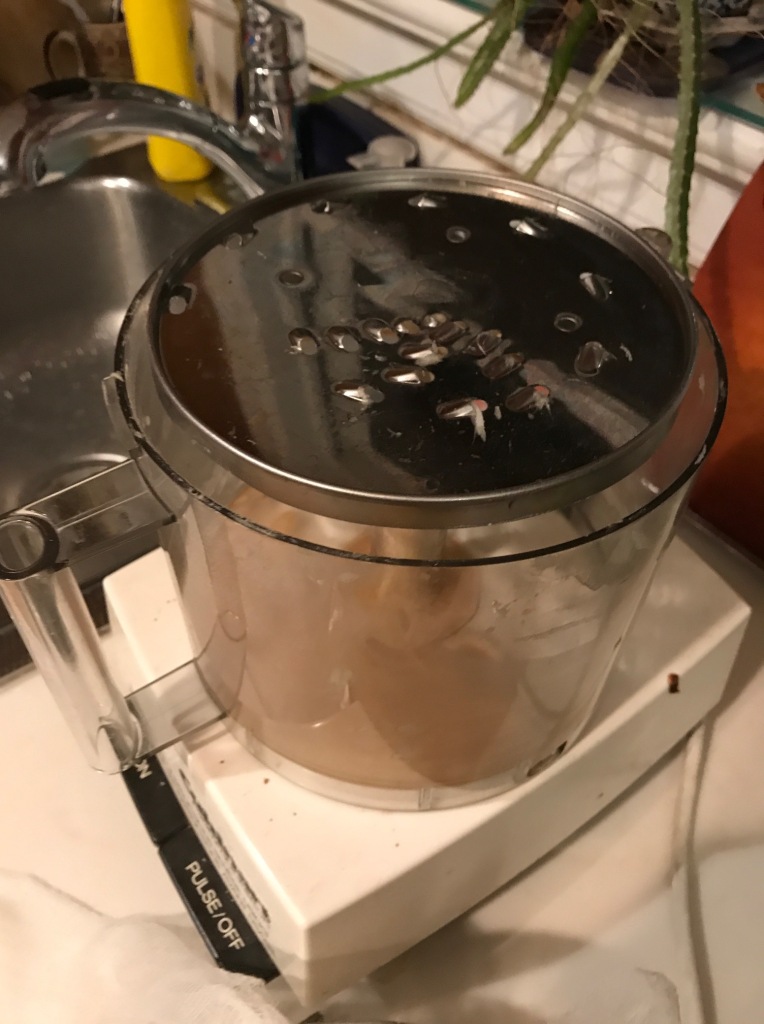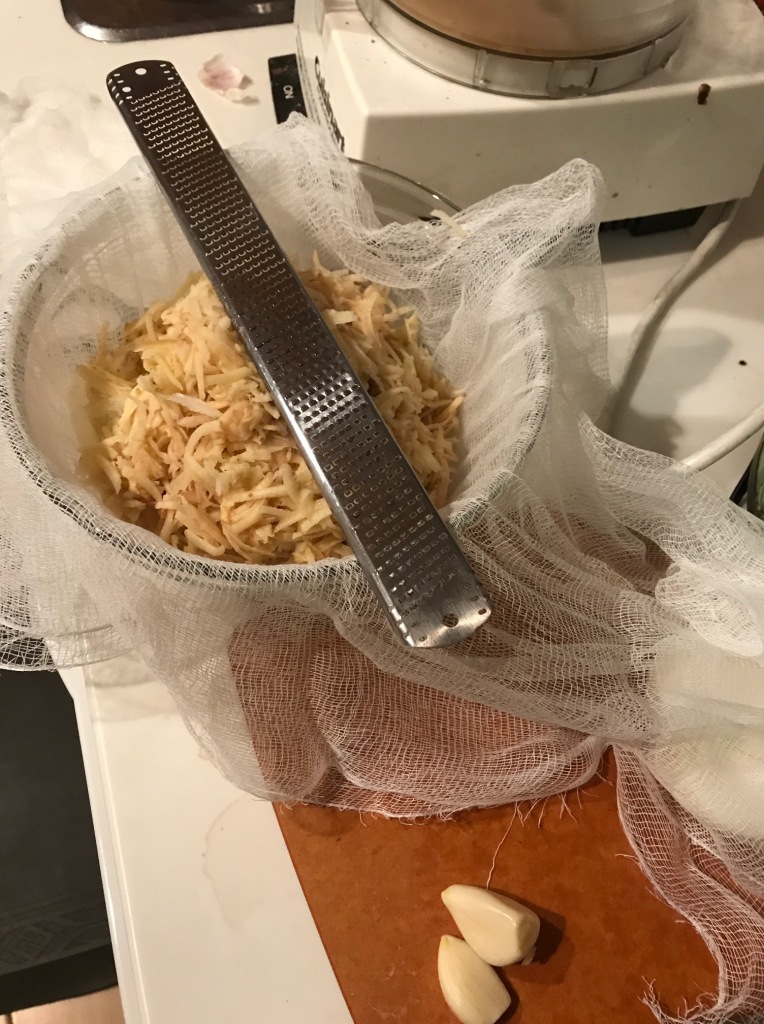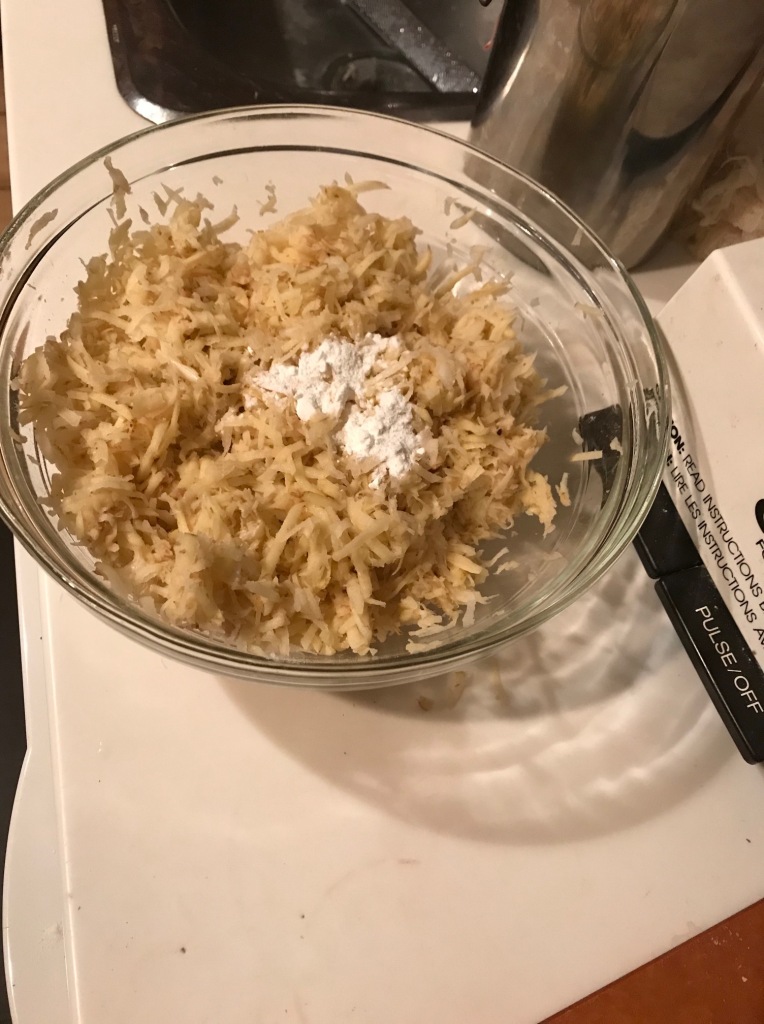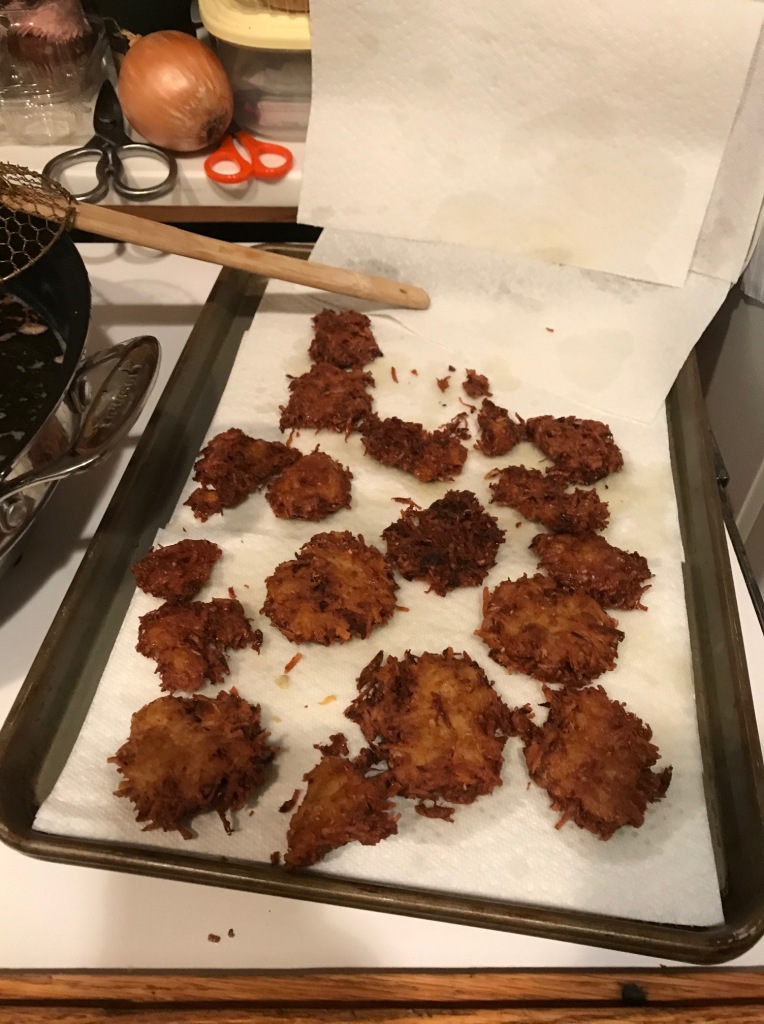It’s Hanukkah… which means ’tis the season for latkes. I’m usually low carb, but I make an exception for latkes. The ones I brought in to work today for a potluck were my best yet; two colleagues asked me for the recipe, so here is the recipe, as well as the techniques.
Ingredients:
2-3 potatoes
1/2 large yellow onion
2 cloves garlic
1 tbsp brown rice flour
1/2 tbsp potato starch
1/4 tsp salt
1/8 tsp black pepper
1 tsp baking powder
2 eggs
Method:
- Grate the potatoes and onion. Use either a box grater or a food processor with a grating blade.
- Line a bowl with cheesecloth (if making this recipe; use a clean cotton tea towel if doubling the recipe), and then dump the grated potatoes and onion on the cheesecloth.
- Using a rasp, “grate” the garlic over the onion and potato. If you don’t have a rasp, chop it finely and set it aside
- Squeeze out as much liquid as possible from the potato, onion, and garlic (if you used the rasp). I squeeze the ball as much as possible, then put it into the (clean) sink and lean on it, until it doesn’t release more liquid when squeezed. It should feel dry to the touch and not have any more liquid to ooze out.
- Once satisfied, put the dry onion and potato mixture into a clean bowl. Add the garlic if you haven’t already. Add the salt, pepper, rice flour, potato starch, and baking powder. Mix thoroughly with your bare hands – you want everything thoroughly blended and spread evenly throughout the mixture.
- Add in the eggs; give them a little stir and mix in. The mixture will be a little wet now.
- Add oil to your electric frying pan: aim for depth of at least 1cm. Set the temperature to 375F. Test if it’s hot enough by dropping in one bit of grated potato – if it sizzles, with tiny bubbles all around it, it’s ready
- Spoonfuls: about 3 cm long by about 3 cm wide, and slightly more than 1/2 cm deep will make for a crispy latke with a tender centre. If you make them a bit bigger and 1cm thick, the time it takes to cook through is quite long, and they’re less crispy but there’s lots of tender filling. They’re good both ways, but the crispiness of the smaller, thinner ones plus the speed of cooking is my preference.
- Flip them when they’re golden on the bottom; medium gold if they’re the smaller ones, fairly dark gold if they’re the thicker kind. Cook the other side until they’re the same colour.
- Test one latke to make sure it’s fully cooked. (And good luck “testing” only one!)
- Drain the latkes on a cookie sheet that has several layers of paper towels. Use another paper towel layer to blot the tops.
- Once cool, transfers to a platter or storage container
Makes a small batch, but is easily doubled or tripled.
Timing: I made two batches for my work potluck, used a Cuisinart food processor and an electric skillet, and it took me two hours from start to finish.
Notes:
- Potato choice is important: you want dry, starchy potatoes. Old potatoes are much better than new, as they’re drier. As for varietals, Russets are best, Yukon gold are second best.
- Filler: regular recipes use matzah meal, and some use flour (there’s debate as to what’s best). You could use GF matzah or flour, but the rice flour is a good compromise – not as fine, a bit gritty, absorbs moisture. You can leave it out, but then they’re not as crispy.
- Garlic isn’t traditional, but it does add a very nice, subtle touch
- Salt: regular salt is fine, but I prefer a 50-50 blend of pink Himalayan salt and Celtic sea salt. It just tastes good.
- Pepper: don’t use much. This is the one food that is best if barely seasoned.
- While a cast-iron frying pan or stove top skillet will work well, an electric frying pan is ideal as it keeps the oil temperature even the entire cooking time. The steady heat and situated on a pull-out counter means my cabinets don’t get spattered with oil.
- Oil: while olive oil is symbolic (since the holiday celebrates how one jar of olive oil miraculously lasted eight days), olive oil’s smoke point is too low for frying. Plus, it’s pricey. I used cheap canola (it’s inflammatory so I only use it when frying). I’ve read that adding a little shmaltz (rendered chicken fat) adds good flavour, but I’d run out so will have to try that another time.
- Latkes are best served fresh and hot, but if you’re making them in advance: store them in a container with paper towels on the bottom and top, to absorb moisture. If you’re serving them the next morning, don’t fully close the container overnight (but you can in the morning if serving at lunchtime). That will keep them as crispy as possible!
- Many people serve latkes with sour cream and applesauce, but I’m a purist – I like to savour pure greasy potato goodness with no (delicious) add ons that soften the crispy effect.

To grate the onion and potato 
Adding the garlic, before squeezing it dry 
Adding the rice flour, salt & pepper, and baking powder to the squeezed dry potato, onion, and garlic 
The set-up 
After a flip 
Cooling latkes
